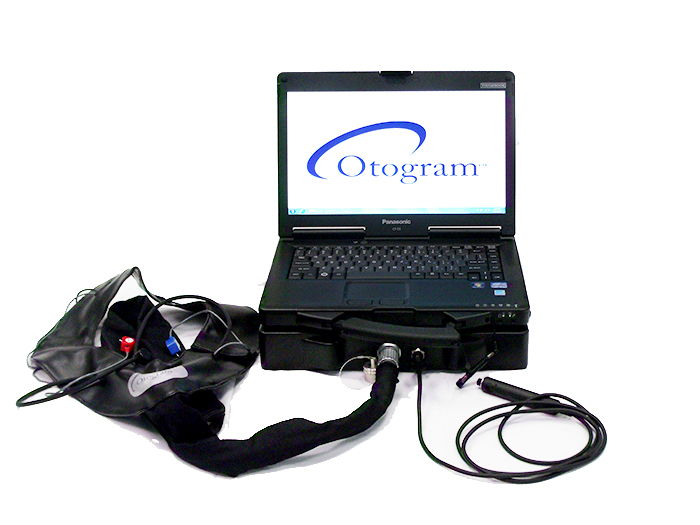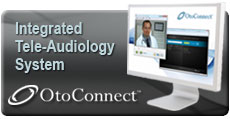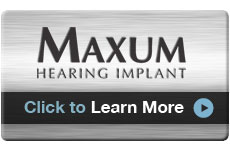- Overview
- Identification
- Diagnostics
- Balance
- Treatment
- Tele-Audiology
Otogram™ Hearing Diagnostic System 
 The Otogram is an interactive diagnostic technology, designed to perform a comprehensive battery of audiological tests. It is capable of being operated in an automatic, computer-assisted or manual mode. It uses sophisticated software and tools to administer the tests with a single device. Traditionally, this would require multiple machines with conventional products. The Otogram tests may be performed by qualified, trained technicians or other hearing health specialists including audiologists. The Otogram does not change the underlying principles or methods for audiometry, nor does it produce results different from manual audiometry.
The Otogram is an interactive diagnostic technology, designed to perform a comprehensive battery of audiological tests. It is capable of being operated in an automatic, computer-assisted or manual mode. It uses sophisticated software and tools to administer the tests with a single device. Traditionally, this would require multiple machines with conventional products. The Otogram tests may be performed by qualified, trained technicians or other hearing health specialists including audiologists. The Otogram does not change the underlying principles or methods for audiometry, nor does it produce results different from manual audiometry.
The patented Ambient Noise Monitoring system uniquely measures and reacts to excessive ambient noise levels throughout the administration of the test, enabling its use in a quiet environment and eliminating the need for a traditional sound booth. If excessive ambient noise levels occur during the test, the comprehensive report will notate the impacted thresholds.
To meet the needs of diverse populations, testing may be administered in one of 13 languages and dialects, including English (U.S., U.K., Australian), Spanish, Italian, Chinese (Cantonese, Mandarin, and Taiwanese), Korean, Portuguese, Vietnamese, Russian, and Arabic.
The Otogram generates customizable comprehensive reports which can include both graphical and numerical representation of the pure tone testing, patient response indicators, predicted and actual scoring on speech intelligibility testing, hearing health questionnaire results, optional reimbursement coding, and a results summary. Reports may be saved in multiple formats for easy integration into EMR systems.
Administrator paging and remote monitoring features enhance the overall effectiveness of the system and optimize the time of highly trained health professionals. The paging system enables patients to be monitored throughout the testing process. Clinicians may confidently review and interpret test results to evaluate next steps and may view live testing from remote locations. The system is fully enabled for tele-audiology applications.
How it Works
Test Environment
The Otogram test may be performed in a quiet room or sound booth. The proprietary Ambient Noise Monitor allows patients to be tested in any quiet exam room rather than a traditional sound booth. This system measures the noise in the ambient environment every 3 seconds to determine if a sound exists in the ambient environment that would compromise the current test frequency based on ANSI standards. If ambient noise is present at an interfering level, the Otogram will make three attempts to re-present the tone. If the ambient noise exceeds the presentation level of the tones, the stimulus tone is increased and the report indicates that the recorded threshold was the lowest level that could be measured accurately in the presence of excessive ambient noise.
Test Set-up
Test set-up requires four simple steps. The test administrator first selects the desired test protocol from the available protocols in the drop-down menu on the New Session screen. Then, the minimum required patient information is entered. In addition to name and chart number, additional information can be set as required to begin a test. The configurable options include Date, Physician, Administrator, Clinic, Gender, and Date of Birth. Upon completion of data entry, the administrator gives the patient brief instructions for how to respond to each test. Finally, the patient is prepared for the test by fastening the Otovest with the appropriate probes or transducers in place. The <Start Testing> button is then pressed to initiate the selected test sequence. The Otogram will further instruct the patient before each new section of the test battery begins. During the pure tone audiometry and speech audiometry, the administrator does not need to be present. Using the Otogram’s integrated paging system, test administrators can remotely monitor the patient’s progress and respond to testing alerts or help requests as needed.
Test Battery
-
• Air and Bone Conduction with Masking
• Speech Reception with Masking
• Speech Discrimination with Masking
• Tympanometry
• Distortion Product Otoacoustic Emissions
• Acoustic Reflexes
• Stenger
• Self Assessment Survey
Reports
Upon completion of the Otogram test a report of the results is generated. Every Otogram test is automatically archived and can be recovered for review at any time. Archived reports can be sorted, grouped or filtered based on multiple criteria. In addition, report outcomes can be analyzed using statistical measures of mean, standard deviation and variance.
Audiogram Graphics: Graphic representation of frequency-specific pure tone air and bone conduction thresholds and acoustic reflexes
Audiogram Table: Numerical display of pure tone air and bone conduction thresholds with associated masking levels and air/bone gaps
Speech Table: Report of both predicted and measured speech scores with details regarding how much of a patient’s score cannot be explained by the degree of hearing loss
Test Summary: Review of ear-specific results with acknowledgement of any asymmetry
Case History: A comprehensive series of hearing and general health questions with writable comment fields
Self Assessment Survey: Five available surveys designed to identify a patient’s specific hearing related challenges
Otoscopic Images: Allows video-otoscopic or other images to be uploaded into the patient record.


